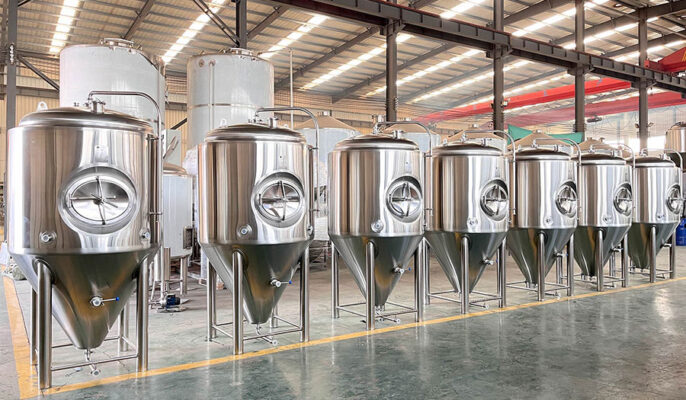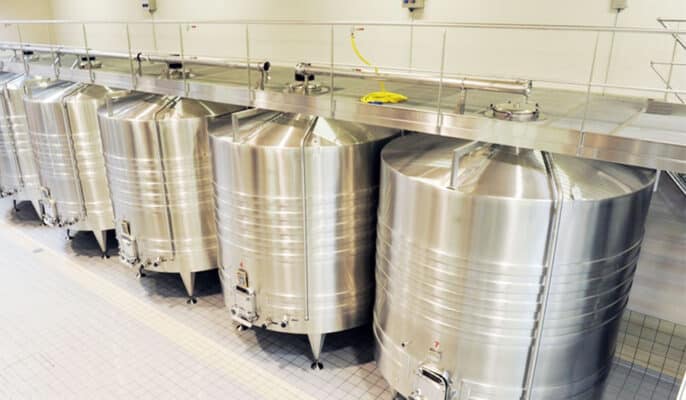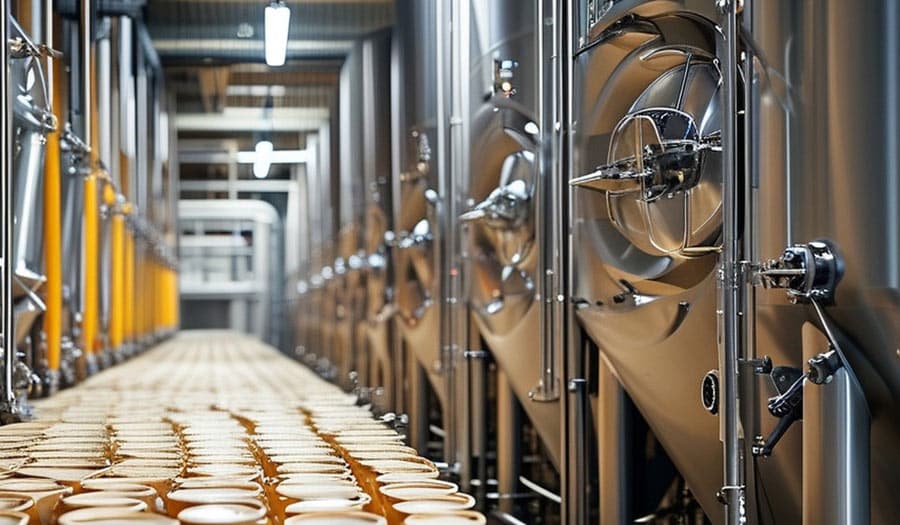Les cuves coniques de fermentation de la bière en acier inoxydable représentent l'un des principaux équipements de brassage, combinant la résistance à la corrosion et une conception conique pour garantir un processus de fermentation efficace et hygiénique. Le corps de la cuve de fermentation est généralement fabriqué en acier inoxydable de haute qualité, ce qui lui confère une excellente durabilité et une grande facilité de nettoyage, et permet de contrôler parfaitement la température et la gestion des levures au cours du processus de brassage. Dans cet article, vous pourrez explorer en profondeur le processus de brassage des cuves de fermentation en comprenant leur structure et leur fonction.
Qu'est-ce qu'un cône en acier inoxydable ? cuve de fermentation?
Les cuves de fermentation, également appelées cuves de fermentation ou récipients de fermentation, sont des conteneurs utilisés pour contenir des substrats tels que le moût ou le jus de raisin en vue de la fermentation. Ces cuves fournissent l'environnement nécessaire à la levure ou à d'autres micro-organismes pour transformer les sucres en alcool et en dioxyde de carbone. Les cuves de fermentation coniques en acier inoxydable sont un type d'équipement professionnel utilisé pour la bière ou d'autres boissons fermentées. La principale caractéristique des cuves de fermentation coniques en acier inoxydable est qu'elles sont fabriquées à partir de matériaux en acier inoxydable de haute qualité et qu'elles ont une forme conique. Voici ses principales caractéristiques et fonctions :
- Matériau : Les cuves de fermentation coniques en acier inoxydable sont généralement fabriquées en acier inoxydable 304 ou 316, qui présentent une excellente résistance à la corrosion et une grande durabilité, et peuvent rester hygiéniques et stables dans le cadre d'une utilisation à long terme.
- Conception conique : La conception conique permet aux sédiments produits au cours du processus de fermentation (tels que la levure, les protéines, etc.) de se concentrer naturellement au fond de la cuve. De cette manière, les brasseurs peuvent facilement éliminer ces sédiments sans les mélanger au produit final, ce qui permet d'obtenir une bière plus claire.
- Système de contrôle de la température : De nombreuses cuves de fermentation coniques en acier inoxydable sont équipées d'un système de contrôle de la température afin de garantir que le processus de fermentation se déroule dans la plage de température optimale. Cela est essentiel pour la santé de la levure et la qualité de la fermentation.
- Vanne de vidange et orifice d'échantillonnage : Ces cuves sont généralement équipées de vannes de vidange pour l'évacuation régulière des sédiments et d'orifices d'échantillonnage pour permettre aux brasseurs d'effectuer des contrôles de qualité et de prélever des échantillons.
- Nettoyage et entretien : L'acier inoxydable facilite le nettoyage et l'entretien de ces cuves, ce qui empêche la prolifération de micro-organismes et garantit l'hygiène du processus de fermentation.
- Étanchéité : Les cuves de fermentation coniques ont généralement une bonne étanchéité, ce qui permet d'empêcher efficacement l'entrée d'air et de polluants, tout en contrôlant la libération de dioxyde de carbone et en maintenant un environnement de fermentation stable.

Types de cuves de fermentation coniques en acier inoxydable
La conception et la fonction d'une cuve de fermentation peuvent grandement influencer l'efficacité du processus de fermentation et la qualité du produit. Il existe trois principaux types de fermenteurs : les cuves de fermentation ouvertes, les cuves de fermentation fermées et les cuves de fermentation à capacité variable. Nous examinerons ci-dessous en détail les caractéristiques et les scénarios d'application de chaque type.
Cuve de fermentation ouverte
Une cuve de fermentation ouverte est un simple récipient sans couvercle ni dispositif d'étanchéité. Cette conception permet à la partie supérieure de la cuve d'être exposée à l'air en permanence, ce qui est pratique pour les opérations manuelles et l'accès. Les cuves de fermentation ouvertes sont les plus courantes dans la vinification car, pendant la fermentation du raisin, les peaux et les pépins de raisin flottant à la surface du liquide doivent être pressés ou remués régulièrement pour assurer une fermentation uniforme. Bien que ce type de cuve soit pratique à utiliser, son exposition à l'air la rend plus sensible aux contaminants externes.
Cuve de fermentation fermée
La cuve de fermentation fermée est équipée d'un couvercle scellé conçu pour empêcher tout contaminant externe de pénétrer dans la cuve. Cette conception hermétique est particulièrement importante pour le brassage de la bière, car elle permet d'isoler efficacement l'air et de prévenir l'oxydation et la contamination, réduisant ainsi le risque d'altération et la production d'odeurs. Les fermenteurs fermés permettent non seulement de maintenir un environnement de fermentation stable, mais aussi de mieux contrôler le dégagement de gaz et les changements de température pendant la fermentation, ce qui permet d'obtenir une bière de meilleure qualité.
Cuve de fermentation à volume variable
Les fermenteurs à volume variable ont une conception flexible et sont généralement équipés d'un couvercle flottant et de réglages de volume. Cette conception permet aux utilisateurs d'ajuster le volume du fermenteur en fonction des besoins, ce qui en fait la solution idéale pour les brasseurs amateurs et les petites brasseries. La flexibilité des cuves de fermentation à volume variable permet non seulement d'accueillir différentes quantités de liquide de fermentation, mais aussi de minimiser le contact du liquide de fermentation avec l'air, ce qui améliore la qualité et la stabilité de la fermentation. La polyvalence de cette cuve la rend populaire dans les petits environnements de brassage.
Le rôle des cuves de fermentation coniques en acier inoxydable dans le processus de brassage
Les cuves de fermentation coniques en acier inoxydable jouent un rôle essentiel dans le processus de brassage. Leur conception et leurs fonctions offrent de nombreux avantages au processus de fermentation. Voici quelques caractéristiques clés et leur impact sur la qualité de la fermentation :
- Environnement contrôlé : Les cuves de fermentation coniques en acier inoxydable offrent un environnement de fermentation scellé et contrôlé qui permet d'isoler efficacement les contaminants externes tels que les levures sauvages, les bactéries et les minuscules particules présentes dans l'air. Cette conception hermétique protège non seulement la pureté du produit fermenté, mais assure également la stabilité du processus de fermentation, ce qui contribue à maintenir la haute qualité du produit.
- Régulation de la température : De nombreux fermenteurs, en particulier les cuves de fermentation fermées, sont équipés de systèmes avancés de contrôle de la température. La température est un facteur crucial dans le processus de fermentation car elle affecte directement le métabolisme et la dynamique de fermentation de la levure. En contrôlant précisément la température, le fermenteur peut s'assurer que la levure travaille dans les meilleures conditions, optimisant ainsi les caractéristiques gustatives et la qualité globale du produit final.
- Agitation et mélange : Certaines cuves de fermentation en acier inoxydable sont équipées d'agitateurs intégrés pour un mélange efficace des liquides. Une bonne agitation permet non seulement d'obtenir une fermentation uniforme, mais aussi d'améliorer l'effet du contrôle de la température et de favoriser la santé des levures. Ceci est particulièrement important pour les fermenteurs de grande capacité, car un mélange uniforme peut réduire les différences de température locales et la distribution inégale de la levure.
- Séparation des sédiments : Les cuves de fermentation coniques sont conçues spécifiquement pour traiter les sédiments produits pendant la fermentation. Le fond conique permet à la levure et aux autres sédiments de se déposer naturellement au fond, ce qui simplifie le processus d'élimination ultérieur. Cette conception facilite non seulement l'élimination des sédiments, mais améliore également l'efficacité de la filtration et du traitement du produit final.
- La carbonatation : Certaines cuves de fermentation, en particulier les cuves unitaires, ont également pour fonction d'assurer la carbonatation. Une fois la fermentation terminée, ces cuves peuvent être gazéifiées dans le même récipient sans avoir à transférer le liquide dans un autre récipient. Cette fonction intégrée permet non seulement d'économiser du temps et de la main-d'œuvre, mais aussi de réduire le risque de contamination susceptible d'être introduit au cours du processus de transfert.
Combien de cuves de fermentation dont j'ai besoin pour mon processus de brassage ?
Taille du lot
La capacité de votre lot est le facteur fondamental pour déterminer le nombre de cuves de fermentation dont vous avez besoin. Plus le lot est important, plus vous aurez généralement besoin de cuves de fermentation, mais cette relation n'est pas toujours linéaire et des facteurs tels que le temps de fermentation, le nettoyage de l'équipement et les temps d'arrêt pour l'entretien, ainsi que le débit souhaité, doivent être pris en compte. Par exemple, si l'objectif est de maintenir une production hebdomadaire régulière, vous aurez besoin de suffisamment de cuves de fermentation pour échelonner efficacement les cycles de production.
Capacité de production
Déterminez la quantité de bière que vous comptez produire dans un délai donné. Il peut s'agir d'une semaine, d'un mois ou d'une année. Calculez le volume total de bière que vous souhaitez produire et divisez-le par la taille du lot pour avoir une idée du nombre de lots qu'il vous faudra fermenter. La détermination du cycle de fermentation moyen pour chaque type de bière est l'un des facteurs clés du calcul de la capacité de production.
Pour calculer le nombre de fermenteurs dont vous avez besoin, divisez la production prévue par la taille du lot. Vous obtiendrez ainsi le nombre minimum de cuves nécessaires pour atteindre votre objectif de production mensuelle.
Par exemple, si la production prévue est de 4 000 litres par mois et que la taille des lots est de 1 000 litres, le nombre de cuves de fermentation nécessaires est d'au moins 4. Toutefois, il est important de tenir compte de facteurs pratiques tels que l'entretien, le nettoyage et le chevauchement des lots. Le fait de disposer de fermenteurs supplémentaires permet de tenir compte de ces facteurs et d'assurer des opérations plus fluides. Il est recommandé d'ajouter un tampon en augmentant le nombre de cuves de fermentation pour qu'il soit légèrement supérieur au minimum requis.
Type de fermentation et exigences spécifiques
Chaque processus de fermentation a ses propres exigences. Le brassage de la bière, la fermentation du vin, la production de vinaigre ou les produits laitiers fermentés nécessitent tous des conditions spécifiques, telles que le contrôle de la température, l'exposition à l'oxygène ou le temps de vieillissement. Comprendre les complexités du type de fermentation choisi peut vous aider à choisir le nombre et le type de cuves de fermentation appropriés.
Estimation du temps de fermentation
Si vous prévoyez d'effectuer plusieurs fermentations simultanément, cela aura une incidence sur le nombre de cuves de fermentation nécessaires. La gestion simultanée de différents produits ou lots nécessite des fermenteurs supplémentaires et une programmation minutieuse afin d'éviter toute contamination croisée ou interférence entre les fermentations. La possibilité d'échelonner les fermentations et d'optimiser l'utilisation des fermenteurs peut contribuer à maintenir un calendrier de production cohérent.
Si un lot d'un produit prend 10 jours pour fermenter et que votre objectif est de préparer un nouveau lot tous les 10 jours, vous avez besoin de suffisamment de fermenteurs pour maintenir ce cycle. Il peut s'agir de 10 fermenteurs pour permettre à chaque lot de fermenter indépendamment sans avoir à attendre la fin du lot précédent.
Flexibilité et polyvalence
Envisagez de combiner des cuves de fermentation de différentes tailles afin d'accroître la flexibilité opérationnelle. Les petits fermenteurs offrent une certaine polyvalence pour les lots expérimentaux, les éditions limitées ou les produits de niche. D'autre part, les cuves de fermentation plus grandes peuvent accueillir des séries de production standard et contribuer à améliorer l'efficacité globale. Cette combinaison permet de s'adapter aux demandes du marché et d'essayer de nouvelles recettes.
Envisager des cycles qui se chevauchent
L'utilisation efficace des fermenteurs implique le chevauchement des cycles de fermentation. Pendant qu'un lot fermente, un autre lot peut commencer ou se terminer. Cela permet de minimiser les temps d'arrêt et de maximiser le rendement. En fonction des durées de fermentation, il se peut que vous ayez besoin de moins de cuves de fermentation que le nombre de lots produits si les cycles se chevauchent efficacement.
Contraintes d'infrastructure et d'espace
Le manque d'espace et d'infrastructure peut limiter le nombre de réservoirs disponibles dans une région donnée. Il est essentiel de trouver un équilibre entre l'efficacité opérationnelle et l'espace disponible. L'utilisation efficace de l'infrastructure existante peut nécessiter d'investir dans des fermenteurs plus grands ou d'optimiser l'agencement pour améliorer le flux de travail. Veillez à ce que l'installation réponde aux normes de sécurité et d'hygiène tout en envisageant la possibilité d'une extension future.
Budget et allocation des ressources
Enfin, les contraintes budgétaires peuvent affecter le nombre de fermenteurs que vous pouvez acquérir dans un premier temps. Il peut être possible de commencer avec un petit nombre de cuves de fermentation polyvalentes, puis d'augmenter progressivement le nombre de cuves en fonction des besoins de production et des capacités financières. Lorsque vous calculez le nombre de fermenteurs, ajustez votre plan en fonction des contraintes budgétaires. Pour trouver un équilibre entre le nombre idéal de fermenteurs et les considérations financières, il peut être nécessaire d'investir par étapes et d'établir des priorités en fonction des besoins actuels. En évaluant soigneusement la dynamique des lots, la durée de fermentation, l'échelle de production, le type de fermentation et les besoins de flexibilité, vous pouvez personnaliser votre infrastructure de cuves de fermentation afin d'optimiser l'efficacité et de répondre aux exigences spécifiques de votre travail de fermentation. Bien entendu, vous pouvez également contacter le groupe Micet et les ingénieurs développeront une solution qui vous convient.

Comment choisir la bonne cuve de fermentation conique en acier inoxydable ?
- Capacité : Déterminez votre échelle de brassage pour choisir la bonne capacité de cuve. Pour les brasseurs amateurs ou les petites brasseries, des cuves de fermentation plus petites peuvent être plus adaptées, tandis que la production à grande échelle nécessite des cuves de plus grande capacité. Veillez à ce que la capacité de la cuve corresponde à vos besoins de production afin d'améliorer l'efficacité et la flexibilité.
- Système de contrôle de la température : Si vous devez contrôler avec précision la température de fermentation, il est essentiel de choisir une cuve de fermentation équipée d'un système avancé de contrôle de la température. Assurez-vous que le système de contrôle de la température peut assurer une régulation stable de la température pour permettre une gestion précise du processus de fermentation et optimiser l'activité des levures et la saveur du produit final.
- Matériau : L'acier inoxydable de haute qualité (tel que l'acier inoxydable 304 ou 316) est un critère important dans le choix d'une cuve de fermentation. Ces matériaux présentent non seulement une excellente résistance à la corrosion et une grande durabilité, mais ils simplifient également le processus de nettoyage et d'entretien, ce qui permet à la cuve de rester hygiénique et d'être utilisée à long terme.
- Caractéristiques de conception : Il convient de prêter attention aux détails de la conception de la cuve de fermentation, notamment l'angle du fond conique, l'emplacement et la taille de la vanne de vidange, etc. Ces caractéristiques de conception ont une incidence directe sur la gestion des sédiments et l'efficacité du nettoyage de la cuve. Le choix de la bonne conception peut améliorer la commodité et l'efficacité du processus de fermentation.
- Capacité d'agitation et de mélange : Pour les processus de fermentation qui nécessitent un mélange uniforme, le choix d'une cuve de fermentation dotée d'un agitateur intégré permettra d'assurer l'uniformité du liquide de fermentation. Cela favorise non seulement la santé de la levure, mais améliore également la cohérence et l'efficacité du processus de fermentation, ce qui est particulièrement important lorsqu'il s'agit de fermenter de grands volumes.
- Gestion des gaz : Assurez-vous que le fermenteur est équipé d'un système d'évacuation des gaz efficace pour gérer correctement le dioxyde de carbone produit au cours du processus de fermentation. Cela permet d'éviter une pression excessive et de maintenir la stabilité du réservoir afin d'éviter tout débordement ou autre problème.
- Budget : Choisissez le bon réservoir de fermentation en fonction de votre budget. Les prix des fermenteurs de différentes marques et fonctions varient considérablement. Mettez en balance les performances et le prix et choisissez l'équipement le plus rentable pour répondre à vos besoins tout en maîtrisant les coûts.
- Fournisseurs et services : Le choix d'un fournisseur réputé est une étape importante pour garantir la qualité de l'équipement et des services qui en découlent. Renseignez-vous sur les commentaires des clients et les états de service du fournisseur pour vous assurer que vous obtiendrez un service après-vente de qualité et des solutions aux problèmes après l'achat.
FAQ
Qu'est-ce qu'une cuve de fermentation conique en acier inoxydable ?
Une cuve de fermentation conique en acier inoxydable est un équipement de fermentation en acier inoxydable de haute qualité avec un fond conique, spécialement conçu pour la production de bière ou d'autres boissons fermentées.
Pourquoi choisir l'acier inoxydable ?
L'acier inoxydable présente d'excellentes caractéristiques de résistance à la corrosion, de durabilité et de facilité de nettoyage. Il permet de prévenir la contamination, d'assurer l'hygiène du processus de fermentation et de prolonger la durée de vie de la cuve.
Comment choisir la capacité de la cuve de fermentation ?
La capacité doit être déterminée en fonction de l'échelle de votre brassage. Les brasseurs amateurs ou les petites productions ont généralement besoin d'un réservoir de petite capacité, tandis que les grandes productions ont besoin d'un réservoir de plus grande capacité. Veillez à ce que la capacité corresponde à vos besoins de production afin d'améliorer l'efficacité et la flexibilité.
Quels sont les avantages de la forme conique ?
Le fond conique permet aux sédiments générés pendant le processus de fermentation de se déposer naturellement au fond de la cuve pour être facilement enlevés. Cette conception permet de maintenir la clarté du liquide de fermentation et simplifie le processus de nettoyage et de filtration.




